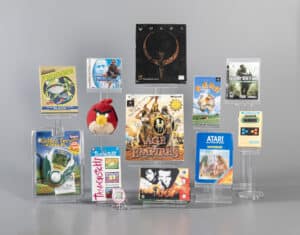The following 12 electronic games are finalists for 2025 induction into The Strong’s World Video Game Hall of Fame in Rochester, New York. The inductees will be announced during a special, onsite ceremony at The Strong National Museum of Play on Thursday, May 8, at 10:30 a.m.

Age of Empires: Created by Ensemble Studios, Age of Empires (1997) infused historical scenarios with turn-based and real-time strategy elements, allowing players to reimagine the rise of civilizations. The game, noted for its fluid and fast-paced play, became publisher Microsoft’s best-selling PC game to that date. Expansions, spin-offs, and sequels followed, creating an enduring franchise still played by millions around the world.
Angry Birds: Launched by Rovio in 2009, Angry Birds became a breakout hit and introduced millions of people to mobile gaming. The conceptually simple game—hurling birds from a slingshot to knock over precariously balanced pigs—becomes increasingly difficult as you play, providing gamers quick fun or endless hours of entertainment. The game has been downloaded billions of times, achieved billions of dollars in sales, inspired movies and massive amounts of merchandise, and captured the public consciousness around smartphone gaming.
Call of Duty 4: Modern Warfare: Call of Duty 4: Modern Warfare is the fourth installment in Activision’s hugely popular Call of Duty franchise. Released in 2007, the game took the first-person shooter franchise from the World War II era to the modern day. It elevated gaming with high-quality animations, compelling stories, and immersive sounds. More than 400 million copies of games in the Call of Duty franchise have been sold across more than 20 titles since 2003, and Call of Duty 4: Modern Warfare has been a crucial piece of the series’ success.
Defender: Released by Williams Electronics in 1981, Defender proved that players would embrace more complex and challenging games in the arcade. Defender married intense gameplay and a complicated control scheme into a horizontally scrolling spacer shooter. It sold more than 55,000 units—high figures for an arcade machine—and helped create a new market for more difficult games.
Frogger: Originally developed by Konami and later licensed by Sega/Gremlin, Frogger jumped into the arcade in 1981. The simple but increasingly challenging gameplay—navigating frogs across a five-lane highway—provided widespread appeal to players of all ages. The game leaped from the arcade into everyday culture, becoming infused with music, TV, and other games. It reached its pop culture pinnacle in a 1998 episode of Seinfeld, where the character George navigated a Frogger arcade cabinet across a busy road, mimicking the gameplay to humorous effect.
Goldeneye 007: In 1997, Rare and Nintendo partnered to release GoldenEye 007 for the Nintendo 64 console, a first-person shooter based on author Ian Fleming’s iconic British superspy James Bond. Lauded for its in-depth story and immersive gameplay, GoldenEye 007 is especially known for its highly popular four-person multiplayer mode, which influenced many multiplayer games that followed. It was the third best-selling game for the Nintendo 64, only trailing Super Mario 64 and Mario Kart 64.
Golden Tee: Fore! Incredible Technologies’ golf game Golden Tee hit the sweet spot with players after debuting in 1989. The game used a simple track ball controller to make golf shots and bring the “links” to the arcade. The game spawned sequels, spinoffs, and updated versions—including a 1995 version that allowed for tournaments to be run via “connected play.” In many ways, Golden Tee was a pioneer in the world of esports. In 2019, 30 years after its release, versions of the game still generated half a billion dollars a year in revenue for operators.
Harvest Moon: Harvest Moon (1996) offered a peaceful farming experience during a time where combat and fast-paced action games dominated the industry. Its innovative blend of life simulation, community-building, and in-game time management established the farming sim genre, influencing countless games such as Animal Crossing, Stardew Valley, Farmville, and many others.
Mattel Football: Released in 1977, Mattel Electronics Football was the first blockbuster handheld electronic game and introduced millions to portable gaming. Its popularity generated an entire segment of electronic toys and games and paved the way for handheld systems like Nintendo’s Game Boy and today’s mobile devices. In 2010, Time magazine named it one of its “All Time 100 Gadgets.”
NBA 2K: First released in 1999 by Sega, NBA 2K focused on realism and minute details, raising the bar for sports simulation games. With 1.6 million daily active users as of June 2018, a pioneering professional eSports league based on the game, 40 million registered users in China for the free-to-play NBA 2K Online, and more than 130 million units sold in the series, NBA 2K has become a global sports powerhouse.
Quake: Id Software’s Quake shook up the gaming world when it debuted in 1996. The first-person shooter’s 3-D engine became the new standard for the industry, and its multiplayer mode helped to spawn the world of esports. The revolutionary Quake game code has been linked to dozens of other games and continues to be used in some modern games nearly 30 years after its release.
Tamagotchi: Launched in 1996, Tamagotchi bridged toys and video games. The handheld, electronic game created a digital pet for its owner to nurture and raise by the press of a button—allowing owners to provide affection and attention from birth to adulthood. The popularity of the pet simulation genre of video games was spurred by Tamagotchi, yielding popular games such as Neopets, Nintendogs, and many other social media and app-based games.



